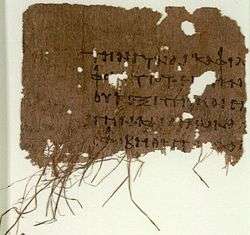Papyrus 103
 | |
| Name | P. Oxy. 4403 |
|---|---|
| Sign | 103 |
| Text | Gospel of Matthew 13:55-56; 14:3-5 |
| Date | 2nd / 3rd century |
| Script | Greek |
| Found | Oxyrhynchus, Egypt |
| Now at | Sackler Library |
| Cite | J. D. Thomas, OP LXIV (1997), pp. 5-7 |
| Size | [16] x [11] cm |
| Type | Alexandrian text-type |
| Category | I |
Papyrus 103 (in the Gregory-Aland numbering), designated by 103, is a copy of the New Testament in Greek. It is a papyrus manuscript of the Gospel of Matthew.
Description
The surviving texts of Matthew are verses 13:55-56; 14:3-5, they are in a fragmentary condition. The manuscript palaeographically has been assigned to the late 2nd or early 3rd century.
Probably together with Papyrus 77 it belonged to the same codex.[1]
- Text
The Greek text of the codex is a representative of the Alexandrian text-type. According to Comfort it is proto-Alexandrian text.
In Matthew 13:55, the name of Jesus' second brother reads [...]ης so that both Ἰωάννης (John) and Ἰωσῆς (Joses) are possible original readings.
- Ἰωάννης (John) א* D M U Γ 2 28 579 1424 Byzmss vgmss Origenpt
- Ἰωσῆς (Joses) K L W Δ Π 0106 f13 22 565 1241 1582mg Byzmss itk,qc cosa,bomss Basil of Caesarea
- Ἰωσῆ (Joses) 118 157 700* 1071 syrh cobomss
- Ἰωσὴφ (Joseph) א2 B C N Θ f1 33 700c 892 lat syrs,c,hmg mae-1 Codex Schøyen cobomss Origenpt
- Location
The manuscript is currently housed at the Sackler Library (Papyrology Rooms, P. Oxy. 4403) at Oxford.[2]
See also
References
- ↑ Philip W. Comfort, Encountering the Manuscripts. An Introduction to New Testament Paleography & Textual Criticism, Nashville, Tennessee: Broadman & Holman Publishers, 2005, p. 73.
- ↑ "Liste Handschriften". Münster: Institute for New Testament Textual Research. Retrieved 27 August 2011.
Further reading
- J. David Thomas, The Oxyrhynchus Papyri LXIV (London: 1997), pp. 5–7.
- Comfort, Philip W.; David P. Barrett (2001). The Text of the Earliest New Testament Greek Manuscripts. Wheaton, Illinois: Tyndale House Publishers. pp. 641–644. ISBN 978-0-8423-5265-9.
External links
Images
- P.Oxy.LXIV 4403 from Papyrology at Oxford's "POxy: Oxyrhynchus Online"
- 103 recto and verso
Official registration
- "Continuation of the Manuscript List" Institute for New Testament Textual Research, University of Münster. Retrieved April 9, 2008